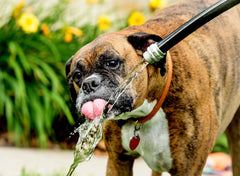
Change of Season Considerations for Your Dog
Fall is here, and as the leaves change color, your dog may be living his best life. There’s nothing better than crisp air and falling leaves to chase. There are squirrels to try and hunt, and hours of exercise to be had outside. However, the temperatures will continue to drop, and the end of the year craziness is about to begin. This major change of season can introduce new dangers (or frustrations) with your furbaby.
Autumn brings with it after school activities, family gatherings, and evening fires. All of these things mean less time with your dog. Make sure that you are getting your dog outside as often as possible before the real cold sets in. But, it’s not just exercise that you need to think about.

New Season, New Concerns
Human Cold and Flu Medicine: It’s flu season and everyone wants to have meds on hand just in case the sniffles start. Taste of the Wild states that “Acetaminophen can be problematic to dogs but especially toxic to cats, where it can lead to liver failure and poor oxygen delivery to the body. Ibuprofen and naproxen, often combined with decongestants, can cause ulcers or liver and kidney damage. And certain decongestants, in high doses, can cause seizures and death in pets.” Please keep your medications out of reach.
Consider Daycare: If you are not able to get your dog outside like he needs to burn energy, and the weather isn’t helping the situation, consider a well-approved doggie daycare. You can drop him off and let him play for an afternoon once a week.
Use a Humidifier: Just as humans benefit from humidifiers, our pets do too. Consider one that also purifies the air.
Ticks: Ticks live all year, so don’t be lax about your tick checks.
Dog Allergies: Just as you may be allergic to ragweed or susceptible to hay fever, your dog may suffer too. If you notice allergy symptoms (scratching, sneezing, rashes, etc) take him in for an allergy check.
Consider Age: A new puppy does not handle the cold like a well-seasoned pup does. This can make house-breaking and accidents a challenge. The same goes for older dogs. They are more susceptible to illness, joint pain from the cold, and accidents due to not liking the weather.
Grooming: If the snow has already started, ask your groomer to trim the hair in between the toe pads to help reduce ice and snow from lingering. You will also want to keep your dog brushed regularly to help his winter coat grow in with minimal shedding.
Walking in the Dark: The season change and time change will mean that the sun disappears earlier and earlier. If you are used to walking your pup after work or after dinner, you should invest in reflective gear for each of you.
Know What Grows: Keep an eye on your yard; fall is when wild mushrooms like to grow. While some are harmless, there are others that can be deadly to dogs (and cats).
Anitfreeze: According to Pet Assure “Do not leave antifreeze, coolant or windshield wiper fluid within reach. And do not let pets drink from puddles. These products taste appealing to pets but most are lethal to animals when ingested. Thoroughly clean up any spills from your vehicles. Also, keep your pets on a leash outdoors and steer them far away from any suspect puddles. Consider using products that contain propylene glycol rather than ethylene glycol. Some companies offer non-toxic antifreeze products, such as Sierra. Be sure to have your radiator flushed before you fill it with Sierra and do not mix Sierra with traditional antifreeze.”




Leave a comment